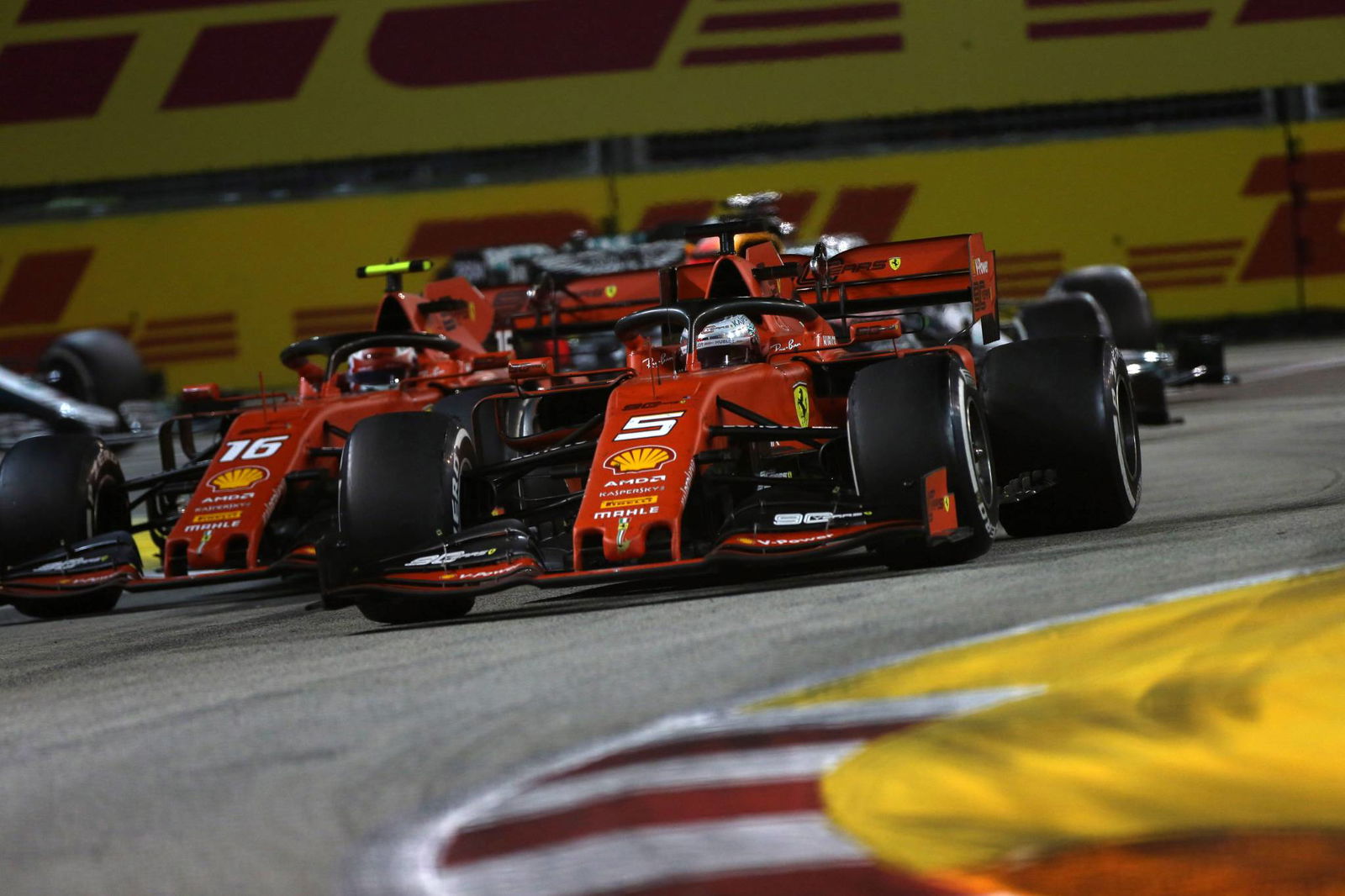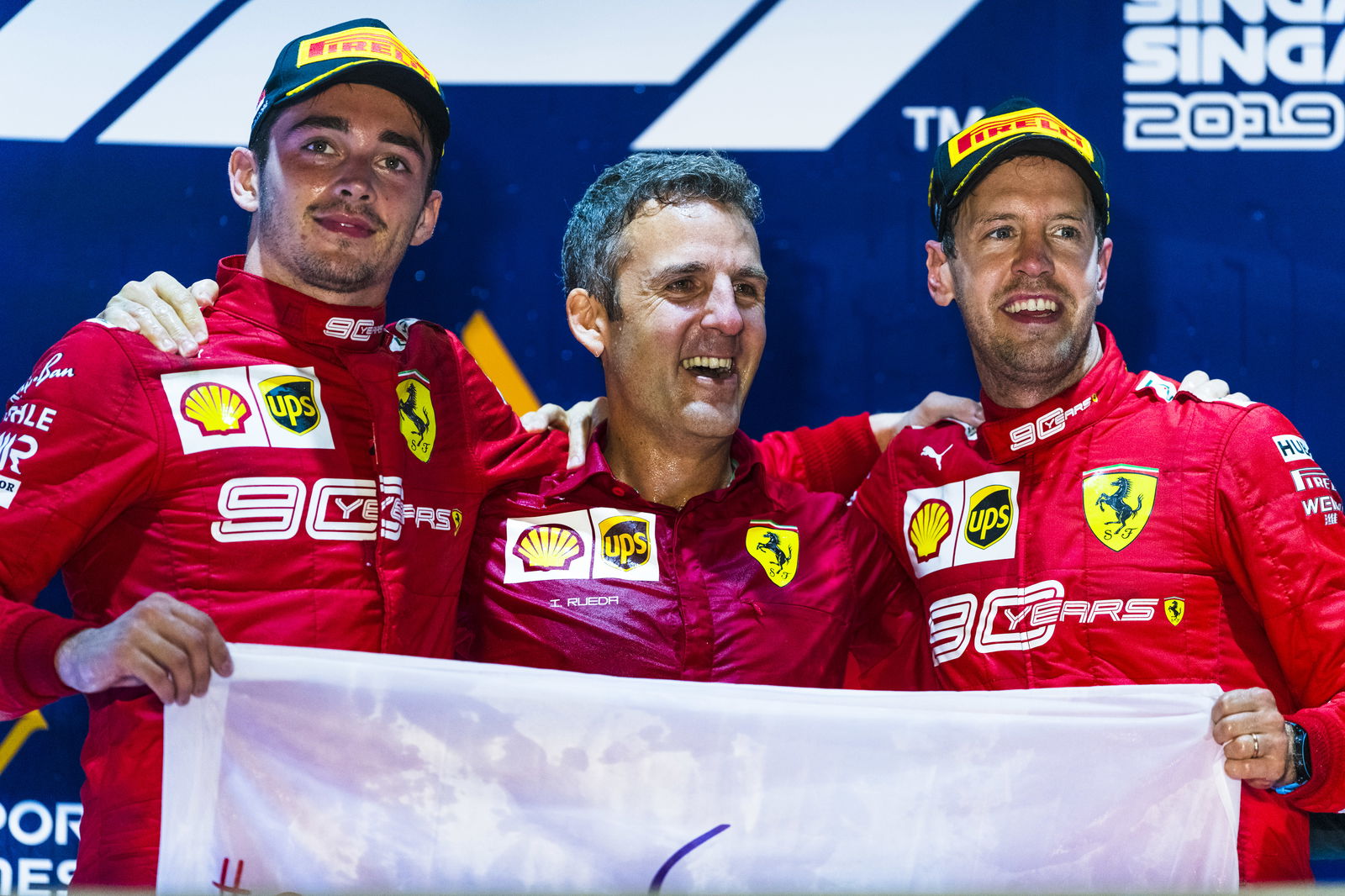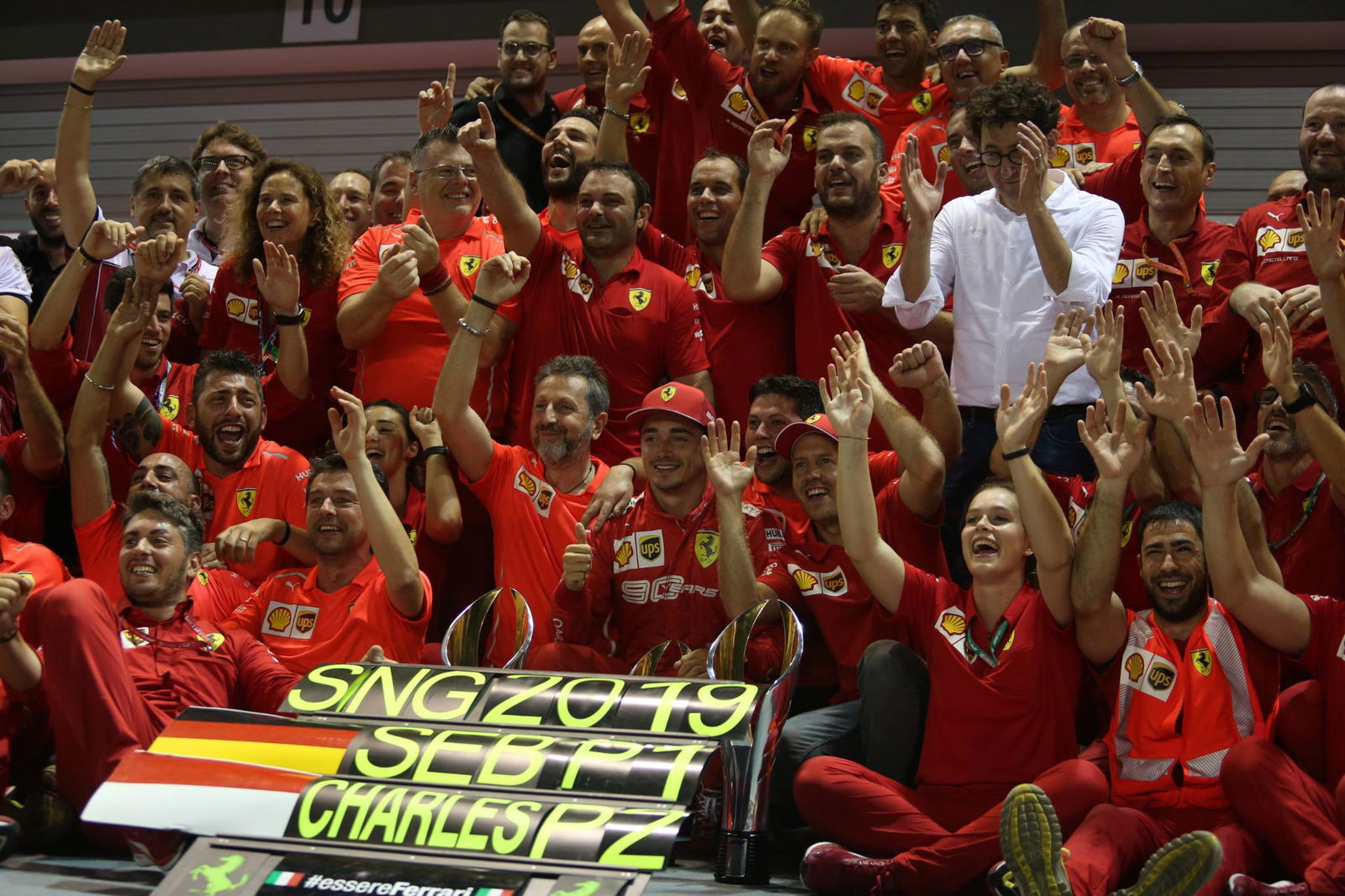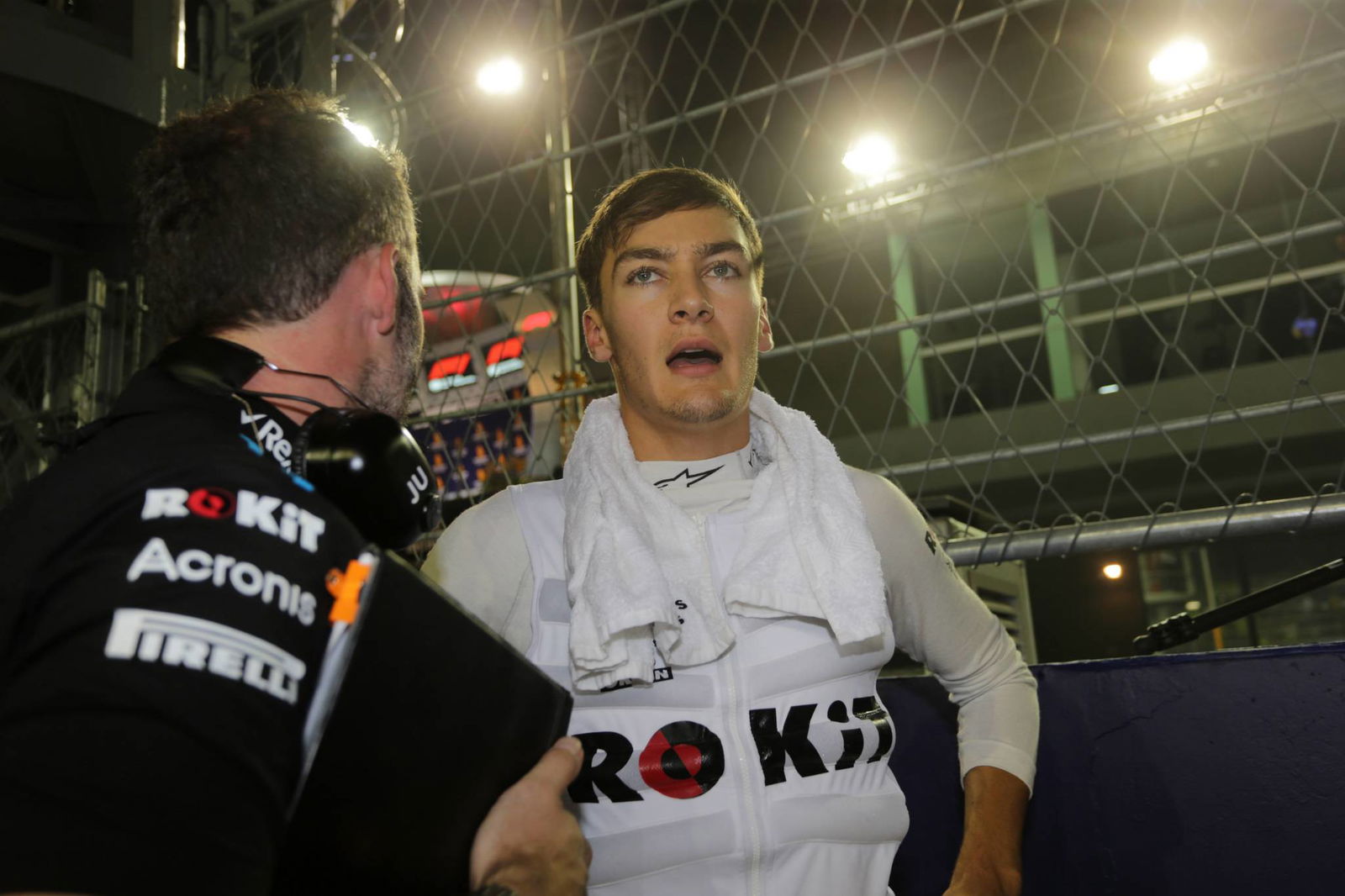F1 Race Analysis: The thinking behind Ferrari’s Singapore strategy
The instant nature of the modern, social media-driven world meant it took mere seconds for judgement to be passed down on Ferrari’s strategy call when its impact became clear.
As erstwhile leader Charles Leclerc snaked out of the pit lane and emerged just behind teammate Sebastian Vettel – who just two laps earlier had been running back in P3 – the knives were quickly out for Ferrari’s pit wall.
On face value, it had appeared to rob victory away from Leclerc in favour of his more experienced teammate.

The instant nature of the modern, social media-driven world meant it took mere seconds for judgement to be passed down on Ferrari’s strategy call when its impact became clear.
As erstwhile leader Charles Leclerc snaked out of the pit lane and emerged just behind teammate Sebastian Vettel – who just two laps earlier had been running back in P3 – the knives were quickly out for Ferrari’s pit wall.
On face value, it had appeared to rob victory away from Leclerc in favour of his more experienced teammate.
Leclerc himself was angry and confused about what had happened, crying “what the hell!” to his engineer. Later radio calls saw him ask again and again what had happened, saying it was “not fair” and asking for all the available tools – including a higher engine mode – to try and recover the victory he believed had been snatched away from him so unfairly.
In reality, though, Ferrari’s rationale for its strategy was sound, even if it may appear muddled. It paved the way for a one-two finish when it could have ended up with just a single car on the podium.
Singapore was always going to be a one-stop race, so great is the time lost in the pits and the importance of track position. As a result, the opening stint proved to be a slow burner as Leclerc kept the field running several seconds off its maximum pace, ensuring his Soft tyres went far enough to avoid multiple stops. As frustrating as it may have been for the entire field to drive within themselves in such fashion, everyone bought into it for the same reason.
The lead runners stayed close together as a result of the gentle pace, with just 6.5 seconds covering the top five – Leclerc, Lewis Hamilton, Vettel, Max Verstappen and Valtteri Bottas – ahead of the pit window opening. All had been waiting for enough of a gap to build to the midfield runners so they could come back out on-track without hitting traffic.
Typically, priority in the pits is given to the driver who is ahead on-track. In theory, it should therefore have been Leclerc, not Vettel, who came in first. But Ferrari went the other way.
“In that case, you would not stop Charles as first he was leading the race, he would have been in traffic, and that would have been the wrong move,” explained Ferrari chief Mattia Binotto after the race.
“The opposite [pitting Vettel first], Verstappen was ready to stop, we knew that, and the best way to protect Sebastian’s position was to stop him. It was the right timing to stop Seb. Following that it was the right timing to stop Charles. I think it was a one-two or two-one.”

Ferrari’s fear was that by pitting Leclerc first, it could have left him in traffic with the likes of Pierre Gasly, Daniel Ricciardo and Lance Stroll. This could have opened the door for Hamilton – who was within a second of the lead – to jump ahead by pitting one lap later. A nice gap had opened up ahead of Hulkenberg for Vettel to drop into, giving him the chance to defend his position from Verstappen and, as a possible bonus, get the jump on Hamilton ahead.
But the undercut proved far more powerful than Ferrari imagined. Even when it had decided Vettel would be coming in first at the end of Lap 19, it still calculated that Leclerc would remain ahead by pitting one lap later. The pit wall’s numbers were off the mark, with Binotto claiming the undercut had been worth 3.9 seconds down to a mix of fresh rubber and a furious outlap from Vettel in clean air.
“The undercut was effectively more powerful than expected,” Binotto said. “It was 3.9 seconds. We were not expecting such a big number. As a matter of fact, when we stopped Sebastian, we thought when Charles stopped the lap after, he would be ahead. Sebastian drove well, got the undercut of 3.9 seconds - that’s the difference.”
Leclerc’s frustration soon became clear over the radio airwaves, yet it was also apparent that Ferrari had pulled a strategic masterstroke. Mercedes told Hamilton to do the opposite to Leclerc on Lap 20, meaning the Briton stayed out, compromising himself further when the penny dropped that the undercut had been the way to go.
Mercedes could have tried to cut its losses by bringing Hamilton in one lap later, but he would likely have come out in P4 anyway as Verstappen had two laps’ worth of undercut to make up. Little harm was done by keeping him out longer, even if he was aided by Bottas slowing things down a bit to protect his teammate from dropping behind both himself and Red Bull’s Alexander Albon.
So what would have happened if Ferrari had pitted Leclerc first, followed by Vettel?
The most likely result would have been a 1-4 finish for Ferrari, with a risk of a 2-4. Leclerc may have hit some traffic, but Vettel proved later in the race just how much quicker the fresher tyres were when it came to dealing with cars ahead. Verstappen also made fairly light work of Hulkenberg, having come out of the pits behind the Renault.

Assuming Leclerc and Verstappen both pitted on Lap 19, Mercedes would have tried to respond with Hamilton – to defend from Verstappen and cover off Vettel – on Lap 20. Ferrari is likely to have done the same with Vettel, but given he was only two seconds clear of Verstappen, he would have fallen back on the undercut. And if Leclerc had lost time in traffic as Binotto feared, he could have lost a place to Hamilton.
Leclerc may not have been happy with it at the time, but Ferrari had the team result in mind first and foremost – something Vettel stressed the importance of after the race.
“I said on the radio after the race that the team is bigger than myself, bigger than any individual. I’m happy for the guys and we finished one-two,” Vettel said.
“For me, the order is important, and for Charles, the order is important. That is why we are here, we ultimately want to fight for victories.
“As I said, the team in this regard is bigger than us.”
Leclerc also showed greater understanding once he had got out of the car, recognising how the strategy had paved the way for the one-two.
“I was surprised because I was not aware in the car, but I guess if this decision has been made, it was for good for the team and it had to be the only way for us to do a one-two,” Leclerc said.
“If this is the case, then I completely understand, but obviously from the car it is a bit frustrating. I’m not completely happy today but anyway, the overall result for weekend is very positive.”
As Leclerc has done time and time again through his 18 months in F1 so far, though, he vowed to learn from this setback. “I will probably do is ask a bit more about strategy around me, who is pitting and who is not because I was not aware,” Leclerc said. “I don’t know if I should have pushed more in the first stint. I don’t know. We have plenty of data and we will analyse it.”
And he was already working to find answers in the immediate aftermath of the race. Entering the final media briefing of the weekend, Vettel turned to Leclerc and said: “You’ve still not changed out of your race suit!”
While Vettel had been chatting to various people throughout the paddock, Leclerc had been upstairs in Ferrari’s hospitality, already getting to the bottom of his defeat.

